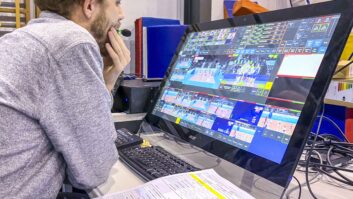
Jan Eveleens, a 25-year veteran of the broadcast technology market, has a merited reputation for being candid. As CEO of Axon, he readily admitted that the industry’s move away from SDI and CAPEX to IP and OPEX has required some internal re-focusing.
“The reinvention piece is basically about the design of the technology, because the people you have on board are all familiar with SDI and all the good old stuff we’ve been using,” he said. “But now there are new terms, new acronyms and new technology and standardisation efforts, so the biggest challenge is to get everybody – from engineering into sales and marketing – up to speed with all the new concepts and buzz terms. That is the biggest challenge right now.”
Eveleens’ IBC was all about the coming of IP. “Everybody is now convinced that the move to IP is for real, and not just another hype. On one hand, they’re happy it’s a genuine trend, but on the other, they still see a lot of challenges on how they are going to implement IP across their facilities,” he said.
The transition poses a big end-user question. “What does it mean to their facility people? They also have to have to reinvent themselves and are facing the same challenges as us in handling the new tools, acronyms and new workflows,” said Eveleens.
“A lot of end-users are not yet ready to commit their core infrastructure to a full OPEX outsourcing model. We talked to some people at IBC and in off-line customer meetings about this because we are designing next generation systems,” he added. “They like the fact that it is CAPEX to OPEX, but the implications of that are that you are not in full control anymore, and you have to rely on somebody else’s platform, hardware or services. Not everybody has accepted that as a general mindset.”
The new mentality
In the IP world, you deploy the physical infrastructure, and once the base configuration is proven, everything becomes software, all of which can perpetually be upgraded. Open-source software was a big factor of IBC.
“Software is going to play a big role in this whole new world. It is replacing the traditional systems, and certainly the move to IP makes us all more software-centric,” said Eveleens. “I am not sure how open-source will be used; we use it and everybody uses it for some parts of their chain. There will also be a lot of proprietary stuff around, and I do not think it will be a fully open situation.
“If you look at SDI, it was a proprietary technology, and many of the tape formats started as proprietary technology. We are an industry with a history of taking proprietary formats and making them the industry standard, so it is not strange that the mentality remains in the industry,” he added. “But moving to IP is software driven, and there is the push towards more generic systems. The new mentality is driven by the influence of the internet, and the broader scale. This will have a huge impact on how the industry is shaped.”
A big switch in the middle
There is upgrading and upgrading, particularly for a facility that has to think about the implications about putting out a live 24/7/365 service.
“What are you going to do? Shut it down for maintenance – like all the cloud servers – for a few hours or days? Leave viewers with no signal for a few days? You cannot do that in broadcast,” said Eveleens. “Taking the concept of upgrading systems may not be as easy in some parts of the industry.”
In Axon’s experience of the end-user world, strange things have happened. Eveleens said, “People going into IP build what I would call almost a one-for-one replacement of the SDI network; they put a big switch in the middle and all the ports connect to the devices in a central approach that is little different from the SDI world.
“The reason for this is that they feel insecure if you start to do fuller distributed or more complex systems. Network management then becomes a real problem, and how you manage the streams,” he added. “A lot of people talk about using SDN technology for that, but very few people understand what they require there, so that’s why most implementations today just adopt the central approach.”
Users are waiting for SMPTE 2110
This can be an advantage as users get to experience a learning curve, but on the downside, it does not give them the full flexibility provided by an IP solution. The conversation switched to the key elements of IP, starting with SMPTE 2110.
“It’s good that this work is happening. Everybody wants it to go faster because many end-users are now saying that they want to verify exactly what the standard is going to be. The fact that due process takes time is slowing adoption down,” said Eveleens.
“I fully agree with the (VRT) suggestion that it is best to start small with IP. There are so many things that everybody has to learn – both vendors and users, and then integrators. If you risk a big project, there is a very large chance that something serious will go wrong; that is not because the technology is particularly difficult or wrong – it is about your people. It’s about the knowledge level of everybody in the chain,” he added. “We all have to learn and make mistakes, because that’s the best way of learning.”
It’s best to avoid the big mistakes, however. At IBC, the issues around IP involved auto discovery, registration and the eventual wonderland of virtualisation.
“The AMWA Networked Media Incubator Project should become part of the SMPTE set of standards,” said Eveleens. “We’re getting there, but there are still open issues. A year ago, we knew the issues but nobody was really working to solve them.
“But the AMWA project has moved everything on quite a bit, so there is now a basic layer – a basic system is described and being implemented. The next thing is the network management/control. This is just a big cloud in the system, and nobody knows how to do that reliably yet,” he added.
Moving to the internet will inevitably raise significant issues with regards to cyber security – which is one reason that large, internet-based companies currently run on proprietary systems.
“There is no one answer for cyber security risk. Once you connect to the internet, sooner than later somebody is going to try and get through your walls. That’s a given,” said Eveleens. “But that’s a generic IT problem. Do not try to solve it from the broadcast end, because the best IT people in banks and the military already know the best practices.
“We are thinking about some of the things you can put in a firewall for video, allowing you to secure that piece of the traffic. Attacks happen, and sometimes they are successful because somebody made an error,” he added.
One central effort
Axon is one of the later members of AIMS, and it joined AMWA last year. What has Eveleens learnt?
“AIMS is a good initiative because it tries to unite a large group of vendors and end-users, to come to a common set of standards. This is a big step forward from when everybody tried to push his own technology forward. In the beginning, we were not sure whether it was just another marketing hype from a few companies trying to get their message across. In fact, real stuff is going on, and AIMS is the best of all activities right now, for reaching that interoperable world in the IP domain,” he said.
“We joined AMWA in 2015 and now everything seems to be converging: AMWA and AIMS are very close, and so too are VSF and SMPTE, so it all starts to become one central effort.”
In addition to his main concentration on IP, Eveleens also has an acute understanding of UHD and HDR.
“UHD is going to happen, but at a slow pace. In the transition to HD, we made mistakes – we allowed interlace to happen, which was really stupid. All the screens used for HD are progressive, so why the heck do we transmit 19080i? We should have gone to 1080p 50/60 right from the off, and we did not anticipate we could do more with the screens in terms of colours and brightness,” he said.
“Now we try to repair that, and most people combine HDR and wider colour gamut with 4K. However, most viewers would not see the difference between a 4K screen with HDR and a 1080p picture with HDR,” he added.
Software is the future
Partnerships have been a big factor in Axon’s progress, and these have involved Dolby and Civolution for technologies, and Utah Scientific for cross selling.
“We cannot do everything ourselves. We don’t have the expertise everywhere, and we don’t have the bandwidth. If you work with the right partners, it makes you stronger, but they also cost energy,” said Eveleens. “We are looking for a few other companies now to see if we can strike partnerships. Especially going into the IP domain, there will be certain aspects we can do, and then some we don’t want to do, or think some are too big a mountain to climb. It’s a pragmatic approach.”
Eveleens, who is one of many people who believe that IBC will become a software show within five years, said, “In the long term we will see virtualisation and people moving into the cloud with their systems and that will be all software. Lights and cameras will never turn into software. The other question is whether NAB and IBC will eventually disappear.”
Skills shortages are a multi-industry concern, and Eveleens has specific views. He said, “There are two elements to this problem. One concerns people that are educated to the domain, so they know what the industry is about and what the basic principles are: they are very hard to get because they are not what many schools and colleges turn out. Software engineers are also difficult to get. The reason for this is that the economy is doing better and lots of companies in many industries are hiring software people.
“Software is the future, but the schools are not turning out as many engineers as they should. Surprisingly, students are not motivated to go into software engineering, so we are importing our engineers from Spain and India.”







